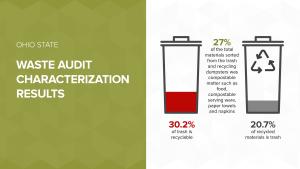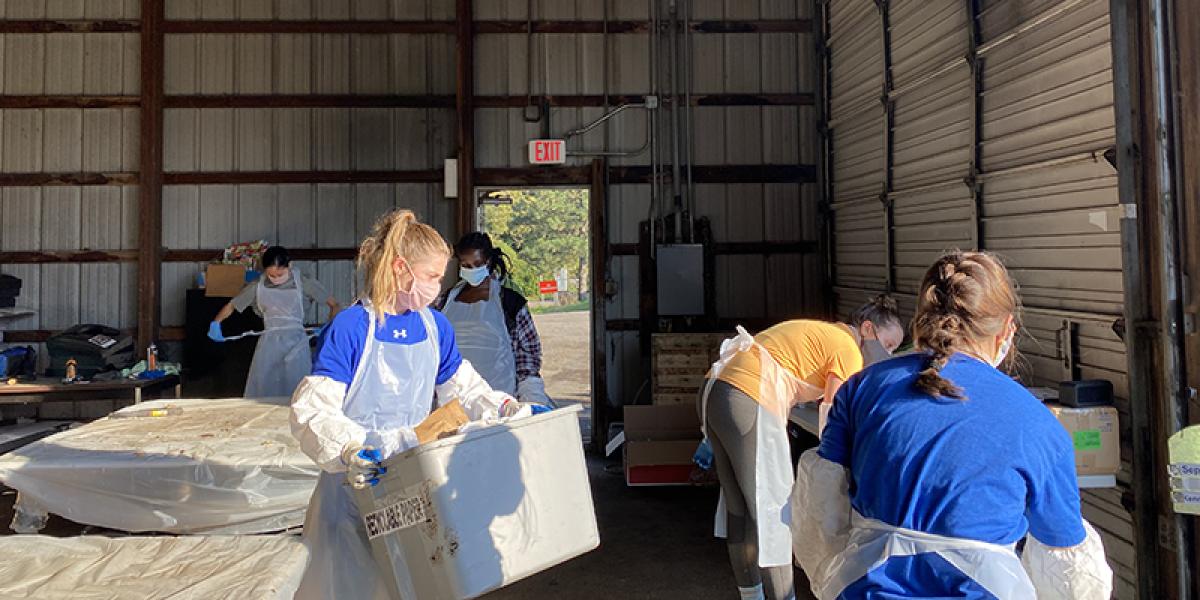
“We were able to create waste profiles for different types of buildings on campus,” said Molly Kathleen, FOD’s zero waste coordinator. “From those results, we can generate new programs that don’t exist today.”
The Waste Characterization Study found:
- 30.2% of the material sorted from trash dumpsters was recyclable;
- 20.7% of the material sorted from recycling dumpsters was contaminated or items they did not accept in the recycling program;
- 27% of the total materials sorted from the trash and recycling dumpsters was compostable matter like food, compostable serving ware, paper towels, and napkins.
“I was surprised by the amount of contamination we had in our recycling as well as how much recycling was ending up in the trash,” said Kathleen. “Now we can develop strategies for improvement.”
If 100% of the recyclables and compostables generated on campus were captured in the proper containers, the team says the university would be able to achieve a 68% diversion rate. In 2021, the diversion rate on the Columbus campus was approximately 36%.
“That would be a fantastic increase we would love to see,” said Kathleen. “We think our biggest gains can be made in expanding compost opportunities.”
To aid in Ohio State’s push to improve the landfill diversion rate, FOD has developed a variety of strategies based on findings from the study.
The sustainability team suggests launching new compost programs with Dining Services establishments that do not have a compost collection service. Adding compost collection to operations that generate animal bedding made from hay or ground corn cobs would also help. There are eleven food service establishments and one lab location on campus that collect organics waste for composting, but there’s still opportunity for program expansion.
“The Mirror Lake Eatery in Pomerene Hall would be an ideal location to provide compost collection service,” Kathleen said. “We are in the process of collaborating with representatives to see if we can expand there.”
They also recommend starting facility walk-through audits to identify opportunities for improvement in underperforming buildings, such as additional recycling bins and better signage. Students could also serve as zero waste ambassadors to staff waste/recycling/compost bins periodically to engage and educate fellow Buckeyes on how to properly use zero waste stations.
Identifying reusable or recyclable alternatives to commonly disposed items and focusing on upstream waste elimination strategies and policies would also help improve the diversion rate. Expanding specialty recycling pilot programs to additional locations and rolling out the “Recycle Right” campaign could also aid in achieving the university’s goal.
Students, faculty and staff also play a key role. They encourage people to brush up their knowledge of what is acceptable in Ohio State’s recycling program and participate in the campus waste diversion programs available. Instead of single-use items, they suggest trying reusable alternatives like water bottles, utensil sets, bags, straws, and food containers.
“Zero waste is an ambitious goal for an institution as large as Ohio State,” Kathleen said. “If we’re going to make meaningful progress towards improving our diversion rate, we need everyone’s participation.”
Kathleen recommends these reasons to recycle and compost:
- Recycling conserves natural resources such as timber, water, and minerals and reduces environmental damage by eliminating the extraction of raw materials.
- Organic matter in landfills is the 3rd leading human-related cause of methane emissions in the U.S. Methane is more than 26 times more potent than CO2 in contributing to global warming. Diverting compostable materials from landfills decreases methane and carbon outputs while creating a nutrient-rich soil amendment.
The second phase of the Waste Characterization Study will include a series of new programs to address the challenges found in phase one. The goal is to create a follow-up audit that measures the impact of the new programs implemented. The examination is scheduled to be completed next fall.

